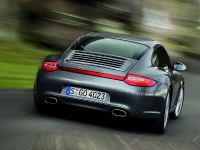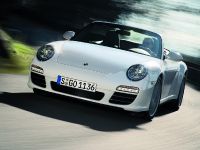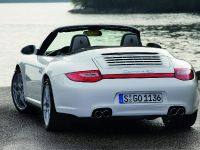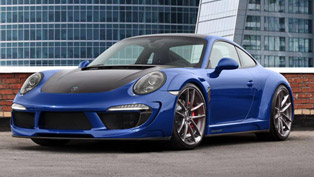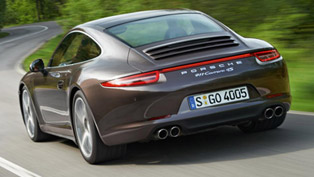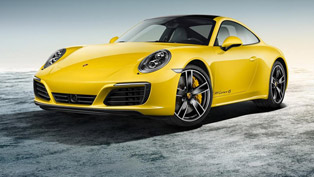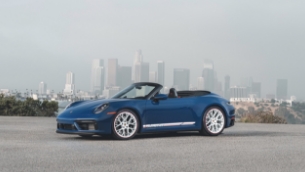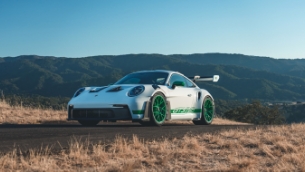Next Generation Porsche 911 Carrera 4 Models Offer New Electronically-Controlled All-Wheel Drive System
Porsche continues the evolutionary change of the 911 model series with the announcement of all-wheel-drive versions of the next generation of its iconic sports car. The new 911 Carrera 4 and Carrera 4S will enter the market in both Coupe and Cabriolet guise, and offer a wide range of innovative engine, transmission and drivetrain technologies providing an even higher standard of driving dynamics combined with much lower fuel consumption.
Porsche Traction Management (PTM) In the new generation 911 Carrera 4 and Carrera 4S, the all-wheel drive is now provided via electronically-controlled Porsche Traction Management (PTM), which replaces the former all-wheel drive with its viscous multiple-plate clutch. The superior PTM system was first developed for the 911 Turbo and has been modified for the Carrera models. The transmission delivers an even higher level of driving stability, traction and agility, further enhanced by the mechanical limited slip differential now fitted as standard to the rear axle.
PTM feeds exactly the right amount of engine torque in each situation through an electronically-controlled multiple-plate clutch to the front wheels, supplementing the flow of power to the rear wheels. Combined with the highly dynamic PTM control system, this clutch precisely delivers a distribution of power and torque to the front and rear axles as road and driving conditions change. With the previous viscous clutch, up to 40 per cent of torque could be directed to the front axle. The new electronically-controlled PTM system delivers an infinitely variable torque split, and is able to distribute up to 100 per cent of traction to the front or rear wheels.
PTM provides a faster and more precise transmission of power in all driving situations, and this offers not only excellent stability at high speeds, but also increases further the level of responsiveness of the car to the driver.
New engines with Direct Fuel Injection (DFI) The 911 Carrera 4 models share their all-new flat-six engines with Direct Fuel Injection (DFI) with the two-wheel drive Carrera 2 and Carrera 2S. The features and characteristics of the new engines speak for themselves. Depending on the model, the all-wheel-drive 911 Carrera offers up to 8.5 per cent more power, fuel economy improved by up to 12.9 per cent, and 15.4 per cent lower CO2 emissions than the previous generation. Specifically, output of the 3.6-litre power unit is up by 20bhp to 345 bhp (254 kW). At the same time, a Carrera 4 Coupe with PDK transmission, to take just one example, offers fuel consumption of 28.0mpg (10.1 l/100 km).
The improvements on the 911 Carrera 4S with its 3.8-litre power unit are equally significant, with maximum output up by 30bhp to 385 bhp (283 kW) and overall fuel consumption down in the case of the Carrera 4S Cabriolet with PDK to 26.4mpg (10.7 litres/100 km).
The driver benefits from a further advantage of direct injection every time he touches the throttle pedal: with fuel being injected fractions of a second prior to combustion, the engines respond more directly and spontaneously to even the slightest movement of the driver's right foot. This is not only the case when accelerating, but also when lifting off the throttle, for engine speed drops more quickly and smoothly since there is no residual fuel left in the intake manifold which might otherwise prolong the combustion process.
Depending on engine load and speed, fuel is injected into the combustion chamber at a pressure of 120 bar. The big advantage is that unlike conventional intake manifold injection, direct fuel injection serves to form the fuel/air mixture directly in the combustion chamber. This better mixes the air and fuel in the cylinder, establishing an important prerequisite for clean and complete combustion. This ensures the ‘homogeneous' operation of the power unit with a consistent balance of the fuel/air mixture in the combustion chamber at all times and under all running conditions. Such smooth operation guarantees optimum combustion and maintains low emissions, across a range of fuel qualities.
Porsche Doppelkupplungsgetriebe (PDK) The new generation 911 Carrera 4 and 4S are available for the first time with the new Porsche Doppelkupplungsgetriebe (PDK), literally Porsche double-clutch gearbox. Offering no less than seven forward gears, the new gearbox combines the driving comfort of a torque converter-equipped automatic transmission with the dynamic manual gearshift functionality of a sequential racing gearbox. PDK also boasts an entirely automatic gearshift function, and replaces the Porsche Tiptronic S automatic transmission previously offered. Through its optimised and adaptive gearshift programmes, PDK further improves the acceleration of the 911 and reduces fuel consumption to an even lower level.
In principle, the PDK consists of a conventional manual gearbox and a hydraulic control system divided into two separate transmission units. Two wet clutches in radial arrangement, controlled hydraulically, and using oil for both cooling and lubrication, form the heart of the transmission. One clutch is for the first transmission unit with the uneven gear ratios (1,3,5,7) and reverse, and the other clutch is for the second transmission unit with the even gears (2,4,6). Via a number of pressure valves, the hydraulic control unit masterminds both the wet clutches and the shift cylinders activating the transmission ratio required.
The gearshift perceived by the driver comes not from the gears actually changing, but from the change of positive clutch engagement. In this case, the clutch on one transmission opens or disengages while the clutch on the other transmission closes or engages in a simultaneous process. The big advantage is an even faster gearshift than with a conventional manual gearbox or torque converter automatic transmission. The gears are already ‘in mesh' when shifting and the power of the engine need not be interrupted in the process.
PDK also reduces to a minimum transmission power loss courtesy of the high standard of mechanical efficiency in the double-clutch, and this manifests itself in fuel economy improvements of approximately 13 per cent compared with a conventional Tiptronic S transmission. PDK also offers an advantage in terms of weight – despite two additional gears, it weighs 10kg less than Tiptronic S.
To use the various functions of the double-clutch transmission, the driver can either shift gears by means of sliding toggles on the spokes of the new steering wheel, or via the new gear selector lever. The driver can press forwards to shift the gears up, and press them from behind to shift downwards. Alternatively, pushing the gear selector lever forwards shifts up a gear, and pulling it back shifts down. The option of PDK costs £2,338.
This PDK gearshift principle was first developed by Porsche for motor sport 25 years ago. Porsche works drivers benefiting from this technology were able to accelerate faster than their competitors and keep both hands on the steering wheel while changing gears, thus avoiding even the slightest distraction while shifting.
The seven-speed PDK shifts gears up to 60 per cent faster than a conventional automatic transmission, and naturally, gives the new 911 Carrera models even better performance. And those in search of optimum driving dynamics have the option to combine PDK with Sport Chrono Package Plus, now featuring Launch Control.
Evolutionary Styling As with the two-wheel drive 911 Carrera models, the new generation of the Carrera 4 is evident through the discreet modification of the nose and tail and its use of new lighting technology. All Carrera models feature, as standard, bi-xenon headlights and new LED daytime driving lights. Dynamic Cornering Lights are available as an option.
The 911 Carrera 4 models are 44mm, or 1.73", wider across the rear wheel arches than the two-wheel drive versions. Further definition and character is added courtesy of a new reflective trim that spans the width between the LED rear lights.
Porsche Communication Management (PCM) Inside the 911, the new Porsche Communication Management (PCM) centre console with its larger, touch-sensitive screen improves operation of the audio system and optional satellite navigation to an even higher standard. And a further important point is that PCM is now compatible with Bluetooth, USB and iPod requirements.
The second generation Porsche 911 Carrera 4 models go on sale in Great Britain and Ireland on October 25. The Carrera 4 Coupe 3.6-litre is priced from£67,430, and the Carrera 4S Coupe 3.8-litre is priced from £74,720. The 911 Carrera 4 Cabriolet is priced from £74,720, and the Carrera Cabriolet 4S from £82,010.
Fitted to every 911 is a Porsche Vehicle Tracking System (VTS), a sophisticated vehicle security package approved to Thatcham Category 5 standard, and owners will also be able to explore the potential of their new car on a Porsche Driving Experience course.

